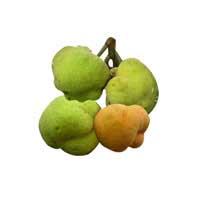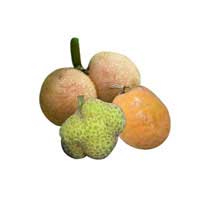 Full List of Fruits
Full List of Fruits  Lakoocha fruit
Lakoocha fruitLakoocha fruit
![]() Introduction of Lakoocha fruit
Introduction of Lakoocha fruit
Scientific name - Artocarpus lacucha
Treasured for its wood, Artocarpus lacucha has many common names like monkey fruit, Monkey Jack and many more. This tropical evergreen tree species is from the Moraceae family. With a large spreading crown, the tree can grow upto 20m in height and it bears out edible fruit that's distributed all over the Indian Subcontinent and Southeast Asia. Preventing soil erosion, the tree provides great shade and it is believed to have some medicinal values, the fruits of A. Lacucha are 5-10 cm in diameter with an irregular lob.
![]() Nutritional Value of Lakoocha fruit
Nutritional Value of Lakoocha fruit
| kcal | 73 |
| Moisture | 90g |
| Protein | 2g |
| Fat | 1g |
| Mineral | 1g |
| Fiber | 3g |
| Calcium | 67mg |
| Phosphorous | 25mg |
Lakoocha has a distinctive flavor that's not found in any other fruit, they are a mixture of sweet, sour, tangy taste with citrusy overtones that resembles kiwi. This pleasant and unusual flavor cannot be expected in other Artocarpus members like durian and cempedak. They are musky and have salty overtones. The skin of the fruit when cut exudes white latex with similar texture of a jackfruit. With a fibrous consistency, they are stringy.
The extract of the fruit reduces hair loss and stimulates the propagation of hair, skin diseases, herpes can make it fade away the darkening of the skin. In addition, it may also treat arthritic swelling, dysentery and clean wounds.
Seeing that, they are very soft, one can force open with hands or even fingers. The flesh of the fruit can be scooped out with a spoon once exposed, if not you can use a paring knife to peel the skin and take out the flesh. As already mentioned, that it exudes white latex; it is good that you grease the knife to prevent milky latex sticking to the knife. As you are done cutting the fruit, ensure that you remove the seeds that are present in each segment. All of lakooch's flesh is edible together with the rags and the supporting meats that don't have seeds. The skin is also edible, but very few choose to take the fruit with the outer layer, however make sure that you avoid consuming the fruit together with its seeds for the reason that they are well-documented purgatives.
With room temperature storage, the fruit continues to get ripe and spoil shortly thereafter, so if you are consuming it immediately, then go for it; else store them in the refrigerator- they can sustain for two or three days. If you wanted to freeze them, make sure you peel the outer layer, remove the seeds and then freeze it. In order to maintain the color and freshness, you can add some amount of ascorbic acid.


















